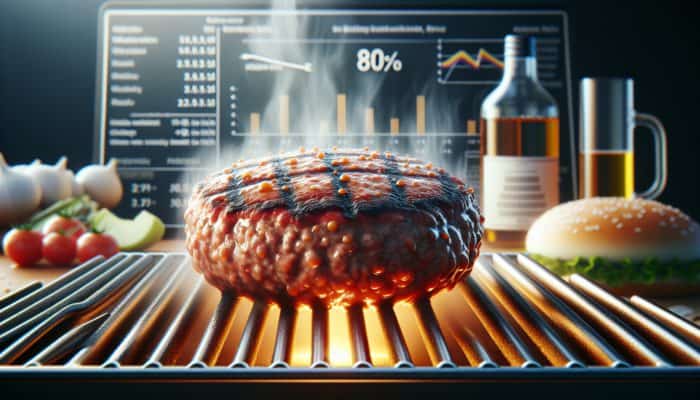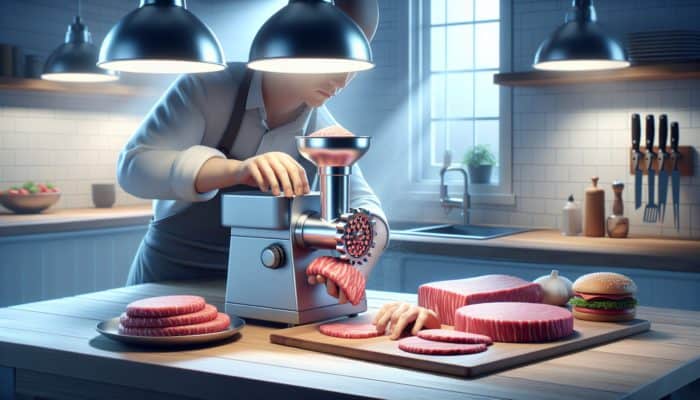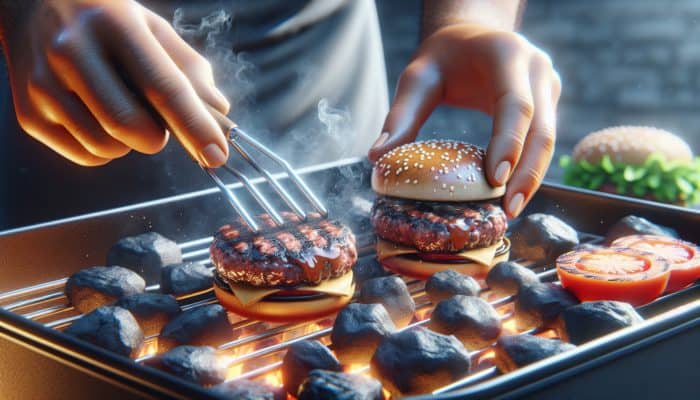Elevate Your Burger Game by Choosing the Perfect Ground Beef for Juicy, Flavorful Patties
Essential Factors to Consider for Selecting the Best Ground Beef for Burgers

When you are on the quest for the perfect ground beef to create mouthwatering burgers, understanding the fat content is a key factor that will ultimately influence the juiciness and flavor of your patties during grilling. For those who are serious about their burgers, the ideal selection is ground beef with an 80/20 lean-to-fat ratio. This perfect combination offers an exquisite balance of rich flavor and moisture retention, resulting in patties that are flavorful and succulent. The fat content not only enhances the richness of each bite but also ensures that your burger remains juicy and tender. On the other hand, opting for ground beef that is too lean, such as 90/10, may lead to a dry and unappealing experience, while excessively fatty options like 70/30 can create greasy burgers that are difficult to handle on the grill.
Another critical consideration is the freshness of the meat you choose. Sourcing ground beef from a reputable butcher is often a guarantee of superior quality compared to the pre-packaged options frequently found in grocery stores. When selecting your ground beef, always look for a vibrant deep red color, which indicates freshness, along with a firm and resilient texture. These characteristics not only signify that the meat is fresh but also suggest it has been well-handled, greatly contributing to the overall quality of your grilled burgers.
Discover How to Select Premium Cuts of Meat to Enhance Burger Flavor
Utilizing high-quality cuts of meat is fundamental for amplifying both the flavor and juiciness of your burgers. The chuck cut is often recommended as the top choice for ground beef due to its excellent balance of flavor and fat content. Many burger aficionados suggest blending chuck with other premium cuts such as sirloin or brisket. The sirloin cut can add a richer beef flavor, while brisket contributes a deep, satisfying richness thanks to its higher fat content, which all work together to enhance the overall flavor profile of your burgers.
As you select your cuts of meat, pay special attention to marbling, which refers to the flecks of fat interspersed within the muscle fibers. A well-marbled cut will create a burger that is not just juicy but also dissolves in your mouth. Moreover, consider grinding your own meat from these premium cuts; this method not only ensures freshness but also gives you the freedom to adjust the fat content according to your personal taste preferences, allowing for a customized burger experience that is uniquely yours.
Understanding the Impact of Fat Content on Burger Juiciness
The fat content present in ground beef plays a crucial role in determining the juiciness of your burgers. A hamburger crafted from ground beef with a minimum of 20% fat typically retains moisture more effectively throughout the cooking process. This is primarily because fat serves as a natural barrier that protects the meat from drying out, resulting in a deliciously succulent texture that enhances the overall enjoyment of the burger. During grilling, the fat renders and generates steam within the patty, which is essential for maintaining moisture throughout the cooking phase.
Conversely, selecting ground beef with insufficient fat content usually leads to dry patties. If you are looking for healthier alternatives, you might try a blend that includes leaner cuts while still achieving a satisfying flavor. Striking the right balance between lean protein and fat is vital to ensure that your burgers remain juicy and enjoyable, effectively avoiding the disappointing experience of biting into a dry burger.
The Advantages of Grinding Your Own Meat for Freshness and Customization

Grinding your own meat provides a level of freshness and control that commercially packaged ground beef simply cannot match. By employing a meat grinder or an attachment for your food processor, you can choose high-quality cuts and dictate the fat-to-lean ratio that aligns with your preferences. This method not only guarantees freshness but also allows for the creation of unique blends tailored specifically to your taste.
When grinding meat at home, it is crucial to keep everything chilled. This practice is important as it helps to maintain the integrity of the fat during the grinding process, leading to a superior texture in your final product. Be sure to thoroughly clean your equipment to avoid contamination. The end result is a burger patty that is fresher, more flavorful, and significantly enhances the grilling experience for both you and your guests.
Effective Techniques for Grilling Burgers While Retaining Juiciness
Professional Strategies for Keeping Burgers Moist While Cooking
Culinary experts utilize a variety of techniques to ensure that burgers maintain their moisture and flavor during the cooking process. A popular method is to create a dimple in the center of each patty before grilling. This technique prevents the burger from puffing up while cooking, allowing for even heat distribution and optimal moisture retention. Another vital practice is to refrain from pressing down on the patties as they cook, as this action releases valuable juices that are crucial for maintaining the burger’s moisture.
Other effective techniques include:
- Using a marinade or brine before cooking to infuse moisture into the meat.
- Adding ingredients like grated onion or Worcestershire sauce to the meat mixture for enhanced flavor.
- Grilling over indirect heat for part of the cooking time to prevent drying out.
- Allowing the patties to rest after cooking to permit the juices to redistribute effectively.
By combining these methods, you will achieve a juicy burger that bursts with flavor while avoiding common pitfalls related to drying out during the grilling process.
Managing Grill Temperature to Prevent Dry Burgers

Controlling the temperature is paramount when grilling burgers. Maintaining a steady grill temperature ensures uniform cooking, which is essential for attaining juicy results. Use a grill thermometer to keep track of the temperature, striving for around 375-400°F while grilling your burgers. This temperature range will allow the exterior to sear properly while retaining the moisture within the patties.
Furthermore, avoid flipping burgers too often. Instead, flip them only once halfway through the cooking process to help keep the juices intact. If you are using a gas grill, adjusting the heat is a straightforward task, while those who prefer charcoal grilling must carefully manage their coals to maintain optimal temperatures. Developing a solid understanding of how to control your grill’s heat will significantly enhance your burger grilling success.
Essential Tools for Grilling Juicy Burgers
Investing in high-quality grilling tools can greatly elevate your burger grilling experience. Key tools include a meat thermometer for ensuring accurate cooking temperatures, a sturdy spatula for flipping patties, and a reliable grill brush for keeping your cooking surface clean. Each of these tools is crucial for effectively managing the cooking process.
For example, a meat thermometer allows you to check the doneness of the burger without cutting into it, ensuring that the juices remain sealed inside. A spatula with a wide surface area is ideal for flipping patties without breaking them apart. Additionally, a grill brush is indispensable for keeping the grates clean, promoting even cooking and preventing sticking. By equipping yourself with the right tools, you set the stage for perfectly grilled, juicy burgers every time.
Steps to Prepare Your Grill for Perfectly Cooked Burgers
How to Properly Preheat Your Grill for Burger Perfection
Preheating your grill is a critical step in the burger grilling process. Aim to preheat your grill to medium-high heat, around 375-400°F. This temperature range is optimal for achieving the perfect sear, which locks in the juices of the burger. Preheating not only guarantees that the burgers cook evenly but also helps prevent them from sticking to the grates.
For effective preheating, close the grill lid and allow it to heat for about 10-15 minutes. This time frame allows the grill to reach an ideal temperature where the grates become sufficiently hot to sear the patties beautifully. A well-preheated grill is the first step toward creating those perfect, juicy burgers that you and your guests will thoroughly enjoy.
The Best Practices for Cleaning and Oiling Grill Grates
An essential step for successful burger grilling is ensuring that your grill grates are clean and well-oiled. A clean grill surface prevents sticking and encourages even cooking, both of which are vital for achieving juicy burgers. Utilize a grill brush to scrub away any residue from previous cooking sessions, ensuring that the surface is free from debris.
Once clean, oil the grates to create a non-stick surface. Use a cloth or paper towel dipped in oil to rub across the grates while the grill is still hot. This simple yet effective action creates a barrier that helps prevent the burgers from adhering, allowing them to sear properly while retaining their moisture. A well-prepared grill is a key ally in achieving the juiciest burgers possible.
Optimal Grill Setup for Perfect Burgers
Setting up your grill correctly is crucial for grilling burgers to perfection. It’s advisable to create two zones: a direct heat zone for searing and an indirect heat zone for finishing the cooking process. This setup enables you to achieve that perfect crust on the outside while ensuring the interior remains juicy and cooked to your desired level of doneness.
To establish this configuration, ignite one side of a gas grill or arrange hot coals on one side of a charcoal grill. Start by searing the burgers over direct heat to develop an appetizing crust. Once seared, move them to the indirect heat zone to finish cooking, which helps prevent them from drying out. This approach allows you to maintain control over the cooking process and serve burgers that are both juicy and flavorful.
Preheating Duration for Burgers
Allowing your grill to preheat adequately is essential for delivering juicy burgers. A preheating duration of 10-15 minutes is generally sufficient for most grills to reach the ideal cooking temperature of 375-400°F. During this period, keep the grill lid closed to trap heat and ensure that the grates heat evenly.
Utilizing a grill thermometer can help you gauge readiness more accurately. Once preheated, you can confidently place your burger patties on the grill, assured that they will sear effectively and maintain their moisture. Paying attention to the preheating process will elevate your grilling game significantly and greatly enhance the flavor and texture of your burgers.
Essential Tools for Successful Burger Grilling
Equipping yourself with the right tools for grilling burgers can significantly enhance your cooking experience. Key tools include a spatula for flipping burgers, tongs for maneuvering patties on the grill, a meat thermometer for checking doneness, and a timer to effectively monitor cooking times.
A heavy-duty spatula is crucial for lifting and flipping patties without causing them to break apart. A quality set of tongs allows you to handle burgers without compromising their structure. A meat thermometer is indispensable for achieving perfect doneness without cutting into the burger, while a timer helps you keep track of cooking times to avoid overcooking. By arming yourself with these essential tools, you will facilitate a smoother grilling process and create mouthwatering burgers every time.
Expert Techniques for Shaping and Seasoning Burger Patties
Proper Patty Shaping for Uniform Cooking
To ensure that your burgers cook evenly and remain juicy, it is essential to shape the patties correctly. When forming patties, be gentle to avoid compacting the meat, which can lead to tough burgers. Instead, lightly handle the meat and create patties that are approximately ¾ to 1 inch thick. This specific thickness allows for even cooking without risking a dry outcome.
An additional helpful tip is to create a small dimple in the center of each patty. As the burger cooks, it will expand, and this technique helps prevent puffing, allowing for more consistent cooking throughout. Striving for uniformity in size and thickness is crucial; this will ensure that all your patties cook at the same rate, helping you achieve that perfect level of doneness every time.
Best Seasoning Techniques for Flavorful Burgers
Simple seasoning can significantly enhance the flavor of your burgers. The most effective method involves using kosher salt and freshly ground black pepper. A generous sprinkle of these two ingredients amplifies the natural flavors of the meat without overwhelming them. For those interested in adding more complexity, consider incorporating garlic powder, onion powder, or even a hint of smoked paprika for an additional flavor profile.
When seasoning, it is best to apply it just before grilling to avoid drawing moisture out of the meat. The objective is to enhance the burger’s flavors while ensuring it remains juicy. Remember that toppings and sauces can also contribute extra flavor, so striking a balance with your seasoning is essential for a harmonious taste experience. The right blend of spices will ensure your burgers remain savory and succulent, making each bite a delight.
Understanding Patty Size and Its Impact on Cooking Time
The size of the patty is a critical factor that directly affects cooking time. Larger and thicker patties will naturally require a longer cooking duration. A standard-sized patty, approximately ¾ inch thick, typically takes around 4-5 minutes per side to achieve medium doneness. However, if you opt for larger or thicker patties, be sure to adjust your cooking time accordingly to ensure they cook through properly.
Utilizing a meat thermometer is a wise choice to eliminate any guesswork; burgers should reach an internal temperature of 160°F for safe consumption. If you’re cooking larger patties, consider switching to indirect heat after searing to ensure that the interior cooks thoroughly without over-browning the exterior. Understanding how patty size impacts cooking time will greatly assist you in serving juicy burgers every time without fail.
Grilling Techniques for Moisture and Flavor Preservation
The Importance of Properly Flipping Burgers
Flipping burgers correctly is essential for preserving moisture and achieving that perfect sear. The golden rule is to flip your burgers only once during cooking. Frequent flipping can lead to the loss of valuable juices, resulting in drier patties. Allowing the burgers to cook undisturbed for the first half of their cooking time enables a crust to form that locks in moisture.
Additionally, when flipping, use a gentle motion with a spatula. Avoid pressing down on the patties, as this action will release juices that contribute to the burger’s flavor and moisture. The goal is to create a lovely crust while preserving the juicy interior. Following this technique will result in deliciously moist burgers that are sure to impress your family and friends at any gathering.
Achieving an Ideal Sear for Your Burgers
Achieving a perfect sear is crucial for locking in the juices and flavor of your burgers. Begin with a hot grill; the initial contact between the burger and the grill should create a satisfying sizzle. This high heat caramelizes the surface, resulting in that desirable crust that everyone loves.
Minimize disturbances during grilling, as this allows the Maillard reaction to occur, leading to a flavorful crust. Once you’ve placed the patty on the grill, resist the urge to flip it too quickly. Instead, allow it to cook undisturbed for approximately 3-4 minutes before flipping. This technique will yield an ideal sear that enhances the overall flavor of your burger while keeping it moist and delectable.
Using the Lid to Control Heat and Moisture While Grilling
Closing the grill lid while cooking burgers is an effective method for maintaining consistent heat and moisture. A closed lid traps steam, creating a humid environment that helps keep the patties moist throughout the cooking process. This technique is particularly beneficial for thicker burgers, which may require longer cooking times.
When you close the lid, it also aids in cooking the patties evenly from all sides, thus reducing the risk of a burnt exterior while the interior remains undercooked. However, be sure to monitor the grill temperature closely to prevent overheating. Using the lid strategically can significantly enhance the juiciness of your burgers, resulting in a delectable final product that your guests will love.
Proven Strategies for Grilling Burgers Without Drying Them Out
Best Practices for Grilling Mouthwatering Burgers
For consistent results when grilling burgers, adhering to best practices is crucial. Always utilize a meat thermometer to check for doneness, ideally removing burgers from the grill just before they reach your desired temperature, as they will continue cooking while resting.
Another key practice is to allow your burgers to rest for about 5 minutes after grilling. This resting period enables the juices to redistribute throughout the patties, enhancing both flavor and moisture retention.
Additional best practices include:
- Using high-quality meat with the appropriate fat content.
- Avoid pressing down on the patties while grilling.
- Creating a dimple in the center of each patty.
- Maintaining a clean and well-oiled grill to prevent sticking.
By incorporating these strategies, you will achieve juicy burgers that are bursting with flavor and sure to impress your guests at your next barbecue.
Ensuring Even Cooking for Your Burgers
To ensure that your burgers cook evenly, a few techniques can be employed. Start by rotating the burgers halfway through the cooking time. This ensures that all parts of the patty are exposed to direct heat, leading to uniform cooking without risking dryness.
Additionally, utilizing the indirect heat zone for the final cooking stages promotes even heating. After searing the burgers over direct heat, move them to the cooler side of the grill to finish cooking. This method prevents charring while allowing the inside to reach the desired doneness, significantly improving your burger grilling results.
By adopting these practices, you’ll significantly reduce the chance of serving dry burgers and elevate your grilling skills to new heights, providing a delightful dining experience for everyone.
The Advantages of Allowing Burgers to Rest After Grilling
Resting burgers after grilling is a vital step that many home cooks often overlook. Allowing the patties to rest for about 5 minutes gives the juices within the meat time to redistribute, preventing a dry burger when you cut into it. When grilled, the juices tend to move toward the surface; resting allows them to flow back throughout the patty, thereby enhancing flavor and moisture retention.
Moreover, resting helps stabilize the temperature of the meat. As burgers cool slightly, they become easier to handle and serve. This practice is not merely about letting the burgers sit; it’s about ensuring that every bite is as juicy and flavorful as possible. Implementing this simple step will truly transform your burger experience, making it unforgettable.
Perfecting Cheese and Toppings for Juicy Burgers
Optimal Timing for Adding Cheese to Your Burgers
The timing of adding cheese to burgers is crucial for achieving the perfect melt without overcooking the meat. It’s best to place cheese on the burgers during the final minute of grilling. This method allows the cheese to melt beautifully while ensuring that the burger remains juicy and tender.
To facilitate even melting, close the grill lid once the cheese is added to the patty. This creates steam that aids in melting without drying out the burger. Opt for cheeses known for their meltability, such as cheddar, Swiss, or American, to complement your burger. This approach adds creaminess and flavor while keeping the burger juicy and satisfying, ensuring a delightful culinary experience.
The Impact of Toppings on Burger Moisture Levels
Toppings can significantly affect the moisture level of a burger. Fresh toppings like lettuce, tomatoes, and sliced pickles not only enhance the flavor profile but also contribute moisture, perfectly balancing the richness of the beef. These toppings introduce freshness and texture, making each bite exciting and enjoyable.
Conversely, toppings that are too hot, such as sautéed onions or grilled mushrooms, should be added after the burger is finished grilling to prevent additional moisture loss. It is essential to be mindful of the moisture content in your toppings, as they can complement the burger rather than detract from its juiciness. Choosing the right combination of toppings elevates the overall eating experience, leading to a more satisfying burger.
Top Toppings for Achieving Juicy Burgers
The best toppings for juicy burgers are those that not only enhance flavor but also contribute to the burger’s overall moisture. Some excellent choices include:
- Avocado – Adds creaminess and healthy fats that contribute to a luscious mouthfeel.
- Bacon – Provides a crunchy texture and savory flavor that complements the beef.
- Sautéed onions – Offer sweetness and moisture when added after grilling, enhancing the overall flavor.
- Fresh herbs like cilantro or basil – Introduce vibrant freshness that brightens the burger.
These toppings should be thoughtfully selected to complement the burger’s main flavor while ensuring that the overall experience remains juicy and satisfying. When combined carefully, these ingredients can elevate any burger to gourmet status, making it a truly memorable meal that guests will rave about.
Preventing Cheese from Making Burgers Soggy
To prevent cheese from making burgers soggy, moderation is key. Use only a moderate amount of cheese when topping your burgers. Adding too much can lead to excess moisture, which, when combined with the juices from the burger, may result in a soggy bun that detracts from the overall experience.
Another crucial tip is to add the cheese at the right moment—during the last minute of cooking. This timing allows the cheese to melt without giving it enough time to release moisture into the burger. Lastly, consider toasting your burger buns slightly before assembly; this can create a barrier that keeps the bun from absorbing too much moisture, ensuring a delightful and crunchy bite with every mouthful.
Monitoring Doneness to Avoid Overcooked Burgers
Proper Use of a Meat Thermometer
Using a meat thermometer correctly is essential for achieving perfectly cooked burgers without risking dryness. Start by inserting the thermometer into the thickest part of the patty, ensuring it does not touch the grill, as this can lead to inaccurate readings. Cook your burgers until they reach an internal temperature of 160°F for well-done results.
If you aim for medium or medium-rare, adjust the temperature accordingly—155°F for medium and 145°F for medium-rare. Remember to remove the burgers from the grill just before they reach your desired doneness, as they will continue to cook while resting. This practice ensures juicy, flavorful results with every burger you serve.
Visual Cues for a Perfectly Cooked Burger
Recognizing the indicators of a perfectly cooked burger is key to serving a juicy, satisfying meal. Look for clear juices oozing from the patty, which is a positive sign that the burger is cooked through without being dry.
Additionally, the texture should feel firm yet spring back when pressed lightly. A properly cooked burger will not feel mushy or overly soft. Moreover, observe the burger for a nicely browned crust on the outside, contributing to that delicious grilled flavor.
Here are some visual signs of doneness to keep in mind:
- Clear juices running from the burger, indicating it is cooked properly.
- A firm texture that springs back when pressed lightly.
- A well-browned crust on the outside, showcasing the grilling process.
- Minimal shrinkage of the patty, suggesting moisture retention.
These indicators will assist you in determining when your burgers are ready to be enjoyed, ensuring that they are both juicy and delicious.
Strategies to Prevent Overcooking Your Burgers
Avoiding overcooked burgers is crucial for maintaining their juiciness and flavor. One effective strategy is to use a meat thermometer to monitor the internal temperature without cutting into the burger. Remove the patties from the grill when they are just a few degrees shy of your target temperature, as they will continue cooking during the resting phase.
Another practical tip is to keep an eye on cooking times based on patty size. Thicker patties require longer grilling times, while thinner ones cook more quickly. Utilizing indirect heat for larger patties can also help prevent the exterior from burning while ensuring that the interior cooks through evenly. By combining these techniques, you can serve perfectly cooked burgers that retain their moistness and flavor, delighting everyone at your table.
Storing and Reheating Burgers to Retain Moisture
Optimal Storage Practices for Leftover Burgers
Properly storing leftover burgers is essential for maintaining their quality and preventing them from drying out. Place the burgers in an airtight container in the refrigerator to keep them fresh. To further protect them from sticking together, consider placing a sheet of parchment paper between individual patties.
This method prevents the burgers from becoming compressed, which can lead to texture changes and moisture loss. Always allow the burgers to cool down to room temperature before sealing them in an airtight container. This practice helps to avoid condensation, which can result in sogginess or spoilage over time.
The Best Method for Reheating Burgers
Reheating burgers can be tricky, as microwaving often leads to dry meat. Instead, gently reheat burgers in a skillet or oven to preserve moisture. For the skillet method, add a small amount of water or broth to create steam, covering the pan with a lid for even heating.
If using an oven, wrap the burgers in aluminum foil to keep them from drying out. Set your oven to a low temperature (around 350°F) and heat until the burgers reach an internal temperature of 165°F. This method helps maintain the quality of the meat while ensuring it’s safe to eat.
Maintaining Burger Quality During Reheating
To maintain burger quality during reheating, focus on gentle techniques that retain moisture. When reheating in a skillet, add a few tablespoons of water or broth to the pan, then cover it to trap steam, which helps keep the meat juicy.
If using an oven, wrap the burgers in foil to prevent moisture loss. Aim for a reheating temperature of about 165°F to ensure safety while avoiding overcooking. Additionally, consider serving reheated burgers immediately to maximize flavor and moisture retention, providing a delightful experience reminiscent of freshly grilled patties.
Safe Storage Duration for Reheated Burgers
Reheated burgers can be safely stored in the refrigerator for up to 3-4 days. It’s important to ensure that they are cooled completely before placing them in an airtight container to maintain their quality and prevent spoilage.
For best results, consume the leftover burgers within this timeframe for optimal flavor and safety. If you need to store them longer than a few days, consider freezing the patties. When properly wrapped, frozen burgers can last for several months without significant quality loss. This way, you can enjoy the fruits of your grilling labor even later, relishing the flavor and satisfaction of your homemade burgers.
Frequently Asked Questions About Burger Grilling
What is the ideal fat content for juicy burgers?
The optimal fat content for juicy burgers is 80/20, providing a perfect balance of flavor and moisture retention to ensure a delightful eating experience.
How can I ensure my burgers do not dry out while grilling?
To prevent drying out, always choose the right meat with sufficient fat content and avoid excessive flipping while grilling, allowing the burgers to cook evenly.
What is the best method for seasoning burgers?
Seasoning burgers simply with salt and pepper enhances their flavor. For those looking to elevate taste, consider adding garlic or onion powder for additional depth.
How long should I grill burgers for optimal juiciness?
Grill burgers for approximately 4-5 minutes per side for medium doneness. Adjust cooking times based on patty thickness to achieve desired results.
What techniques do chefs use to keep burgers moist?
Chefs often create a dimple in patties and avoid pressing down on them while grilling to retain valuable juices, ensuring a succulent final product.
Should I allow burgers to rest after grilling?
Absolutely, letting burgers rest for about 5 minutes allows juices to redistribute within the patties, resulting in a juicier and more flavorful bite.
Is it possible to freeze leftover grilled burgers?
Yes, you can freeze grilled burgers. Just wrap them tightly and store them in the freezer for several months without compromising quality.
How can I prevent my cheese from making burgers soggy?
Use a moderate amount of cheese and add it during the last minute of grilling to limit excess moisture release, ensuring a perfect consistency.
What is the best way to reheat burgers without drying them out?
Reheat burgers gently in a skillet with a bit of water or broth, covered to create steam, or in an oven wrapped in foil to maintain moisture.
How do I know when my burgers are done cooking?
Use a meat thermometer to confirm that the burgers reach an internal temperature of 160°F for safe and enjoyable results every time you grill.
Connect with us on Facebook!
The Article How to Grill Burgers Without Drying Them: US Secrets appeared first on https://pitmastersarsenal.com
The Article Grilling Burgers: Secrets to Keep Them Juicy Was Found On https://limitsofstrategy.com

